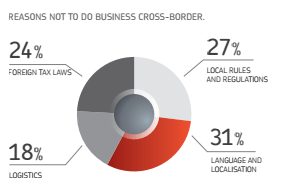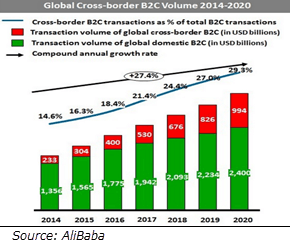The global e-commerce market is growing rapidly and cross-border e-commerce is gaining an increasingly high share of total cross-border commerce over time. As shown on the left, Alibaba expects the cross-border e-commerce market to quadruple from $233B in 2014 to $994B in 2020.
The four most active cross-border e-commerce channels — both in terms of cross-border purchases and cross-border sales — are the US, the UK, Germany and China. Thus, for example:
- For German online shoppers, the UK is the most popular cross-border shopping destination (43%), followed by the US (33%) and then China (24%). German online merchants, on the other hand, sell mostly to France, Austria, Italy, Spain, and the Scandinavian countries. [1]
- 71% of UK online merchants offer cross-border delivery, with the US being the biggest cross-border trading partner (both imports and exports). [2]
- Cross-border purchases by China’s online shoppers grew from less than $2 billion in 2010 to more than $20 billion in 2014. With the Chinese middle-class expected to grow to 630 million by 2022, this trend is only going to increase. [3]
Despite the massive opportunity for increased revenue that cross-border e-commerce presents, there are also several unique and significant challenges that not all e-commerce merchants are willing or able to address. In a recent survey conducted by Payvision[4], e-commerce businesses that have not yet plunged into the cross-border market cited the following main reasons:
Although the world is becoming more and more of a global village, for the cross-border e-commerce merchant it is still hugely fragmented in terms of local consumer protection laws, customs and tariffs, and privacy and data protection regulations. But surprisingly, it is actually the language and localization issues that were the leading reason given not to jump on the cross-border bandwagon. E-commerce merchants are acutely aware that to compete in foreign online markets they must be able to present their products and provide customer care in the local language and in line with the local culture.
Though website translation & localization pose significant challenges, the potential ROI for e-commerce merchants is obvious. Morningside Translations has developed extensive expertise in localization and cross-cultural communications as it helps its customers do business around the globe every day. If you are considering expanding into the cross-border e-commerce market, contact us to see how we can help you make your cross-border e-commerce dreams a reality.
References


